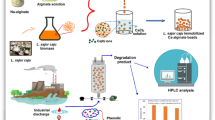Abstract
The application of specialized microorganisms to treat dichloromethane (DM) containing process effluents was studied. An aerobic fluidized bed reactor with a working volume of 801 filled with sand particles as carriers for the bacteria was used. Oxygen was introduced into the recycle stream by an injector device. DM was monitored semi-continuously. A processor controlled the feed volume according to the DM effluent concentration. Mineralization rates of 12 kg DM/mbioreactor 3 · d were reached within about three weeks using synthetic wastewater containing 2000 mg/l DM as single carbon compound. DM from process water of a pharmaceutical plant was reduced from about 2000 mg/l in the feed to below 1 mg/l in the effluent at volumetric loading rates of 3 to 4 kg DM/mbioreactor 3 · d. Degradation of wastewater components like acetone and isopropanol were favoured, thus making the process less attractive for waste streams containing high amounts of DOC other than of DM. DM concentrations of up to 1000 mg/l were tolerated by the immobilized microorganisms and did not influence their DM degradation capacity. The ability to mineralize DM was lost when no DM was fed to the reactor for 10 days.
Similar content being viewed by others
References
Brunner W, Staub D & Leisinger T (1980) Bacterial degradation of dichloromethane. Appl Environm Microbiol 40: 950–958
Diekmann R, Naujoks M, Gerdes-Kühn M & Hempel DC (1990) Effects of suboptimal environmental conditions on immobilized bacteria growing in continuous culture. Bioproc Engin 5: 13–17.
Gälli R & Leisinger T (1985) Specialized bacterial strains for the removal of dichloromethane from industrial waste. Conserv Recycl 8: 91–100
Grass G & Widmer HM (1981) Überwachung des Schadstoffgehaltes in der Luft am Arbeitsplatz. Swiss Chem 3: 117–120
Jongen WH, Alink GM & Koeman JH (1978) Mutagenic effect of dichloromethane. Mutat Res 56: 245–248
Kohler H, Scholz H & Bardtke D (1986) Biologische Elimination von Dichlormethan in Gegenwart leicht abbaubarer Kohlenwasserstoffe. Gwf Wasser/Abwasser 127: 437–441
Müller R & Lingens F (1986) Mikrobieller Abbau halogenierter Kohlenwasserstoffe: Ein Beitrag zur Lösung vieler Umweltprobleme? Angew Chem 98: 778–787
Nörtemann B, Baumgarten J, Rast HG & Knackmuss HJ (1986) Bacterial communities degrading amino- and hydroxynaphtalene-2-sulfonates. Appl Environm Microbiol 52: 1195–1202
Pearson CR (1982) C1 and C2 halocarbons. In: Hutzinger O (Ed) The Handbook of Environmental Chemistry, Vol 3B (pp 68–88). Springer Verlag Heidelberg BRD
Ryhiner G, Petrozzi S & Dunn IJ (1988) Operation of a three-phase biofilm fluidized sand bed reactor for aerobic wastewater treatment. Biotechnol Bioengin 32: 677–688
Scholtz R, Wackett LP, Egli C, Cook AM & Leisinger T (1988) Dichloromethane with improved catalytic activity isolated from a fast-growing dichloromethane-utilizing bacterium. J Bacteriol 170: 5698–5704
Stucki G (1989) Biologische Entsorgung von Methylenchlorid aus Abluft und Abwasser. Swiss Biotech 7: 27–29
Stucki G, Gälli R, Ebersold HR & Leisinger T (1981) Dehalogenation of dichloromethane by cell extracts of Hyphomicrobium DM2. Arch Microbiol 130: 366–371
Sutton PM (1981) Application of the Oxitron fluidized bed process to industrial wastewater treatment. In: Moo-Young M, Robinson CW (Eds) Advanced Biotechnology, Vol 2 (pp 607–613). Pergamon Press Toronto
Sutton PM & Mishra PN (1989) Fluidized bed biological treatment: Effects of full scale-up on system performance (pp 429–440). IAWPRC Conf proceedings. Technical advances in biofilm reactors, Nice
Vogel TM, Criddle CS & McCarty PL (1987) Transformation of halogenated aliphatic compounds. Environ Sci Technol 21: 722–736
Widmer HM, Erard JF & Grass G (1984) Automated monitor systems for the continuous surveillance of environmental samples. Intern J Environm Anal Chem 18: 1–10
Winkelbauer W & Kohler H (1989) Biologischer Abbau von leichtflüchtigen Chlorkohlenwasserstoffen in offenen Systemen am Beispiel von Dichlormethan in einem Tauchtropfkörper. Gwf Wasser/Abwasser 130: 13–20
Author information
Authors and Affiliations
Rights and permissions
About this article
Cite this article
Stucki, G. Biological decomposition of dichloromethane from a chemical process effluent. Biodegradation 1, 221–228 (1990). https://doi.org/10.1007/BF00119759
Received:
Accepted:
Issue Date:
DOI: https://doi.org/10.1007/BF00119759




